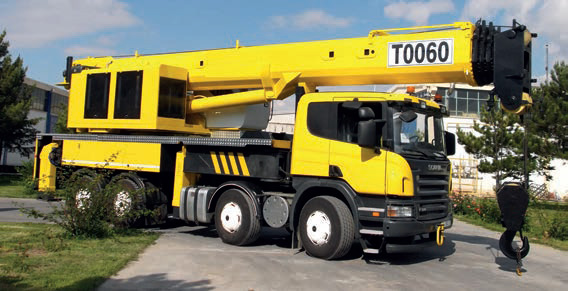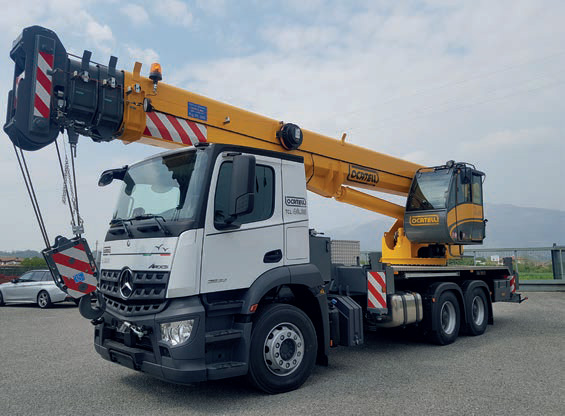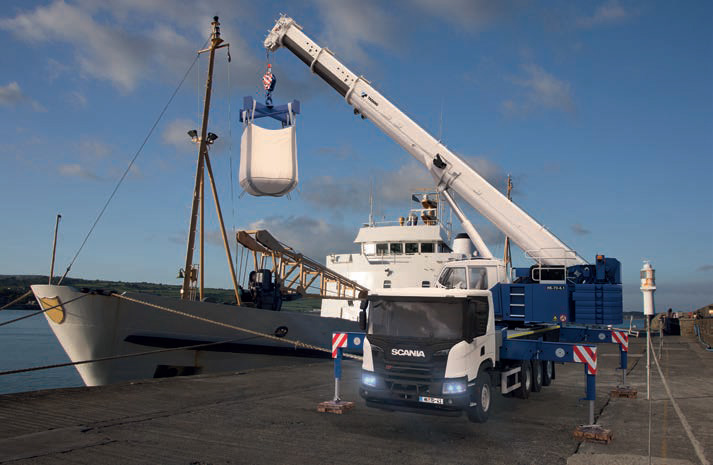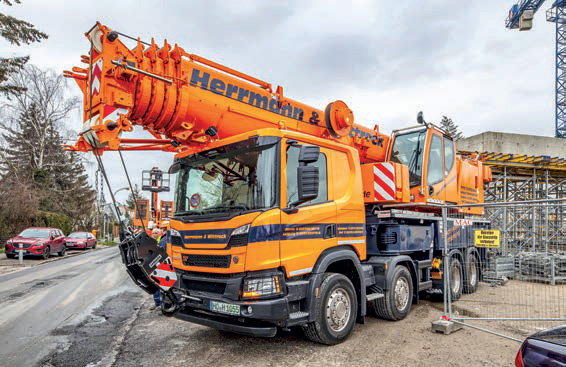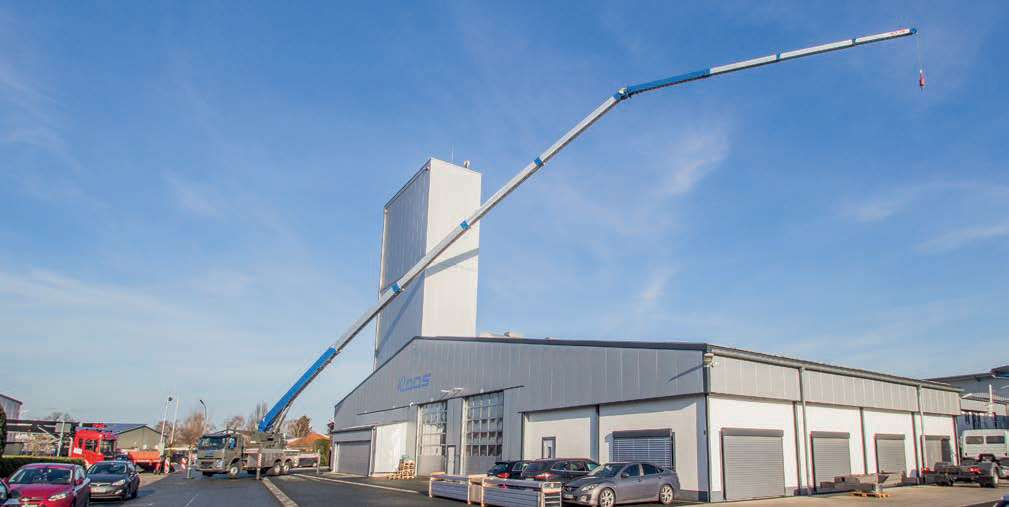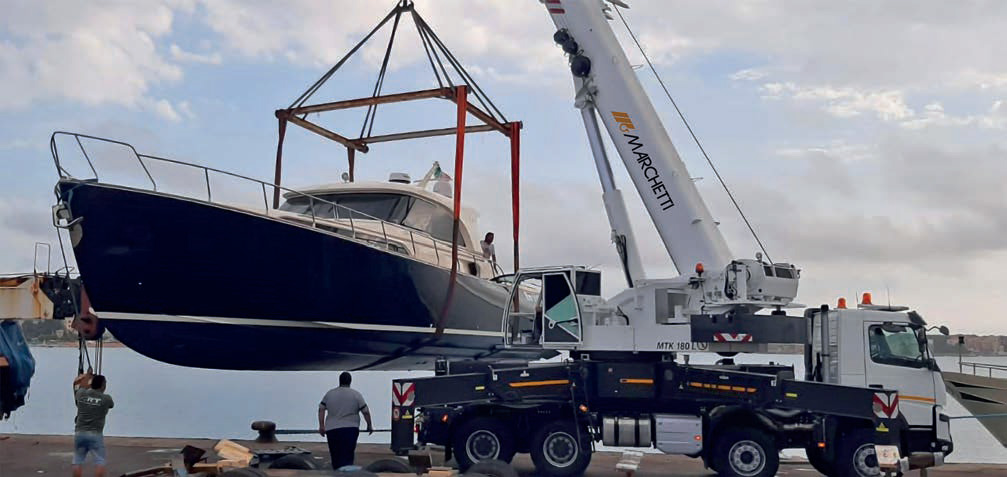Staying on track
4 December 2020The truck-mounted crane is a simple solution to many lifting problems. Julian Champkin finds a growing market for a flexible friend.
Take a crane. Put it on a truck; and you are there. That, essentially, is a truck-mounted crane. It sounds simple, and it is.
All-terrain cranes are also cranes on wheels, but they are more complex. The crane and the chassis are designed together, as a single concept: it is engineering elegance, a solution perfectly designed for its function. A Rolls- Royce car is also engineering and design perfection; but there are times when a small runabout saloon will get you from A to B just as easily, and with a lot less expenditure in money and fuel.
That, essentially, is the advantage of a truck-crane, and is why in many markets truck mounted cranes are eating away at the roles of the smaller all-terrains.
Locatelli Crane make rough terrain cranes and self-propelled City cranes, both on specially designed chassis; they stopped making truck cranes back in the early 1980s. Recently they have returned to the market: the company now again makes truck cranes, which it mounts on standard chassis by Mercedes and Scania. Sales director Michele Mortarino explains why they are revisiting the truck crane:
“The cost of designing and making a dedicated chassis is very high,” he says. “The cost rebounds on the customer, which makes it an obvious disadvantage, and also on the crane-maker. In the case of a small-capacity all-terrain crane, where margins are small, that high cost is not sustainable. That is not just our reasoning, but we believe also the reasoning of many of our competitors.”
Truck-mounted cranes, on the other hand, offer an opportunity to produce new cranes that can perform the same tasks at a fraction of the development costs. The likes of Mercedes, Scania and Volvo have already done the chassis development, and can set the costs against their large volume sales. For the crane-maker, and for the crane-buyer, it is a win-win situation.
“As small all-terrains become too expensive to make or to buy, a gap in the market opens for us. We can bring out a new range of products at small investment for a big result,” says Mortarino.
Which is exactly what Locatelli Crane have done. “We launched our three-axle TCL 40.35 as a completely new product a year ago,” he says. “It is proving very popular in Europe and the Far East.”
The approach of the company is a step-by-step introduction to span, eventually, the capacity range: “We have neither the desire nor the size to introduce the whole range in at a single step. So we presented the three-axle 35t capacity truckmounted crane as our first model.
It shares the main boom and the cabin with our brand new 47t rough terrain crane; we have downsized some of the components, which gives us a compact but still powerful crane on three axles. We have sold a good number of these. We chose Mercedes and Scania chassis because they give good performance and offer a worldwide after-sales and support network: wherever in the world our customers are, they are there also. Three axles give a manageable size that is easy for customers to drive and to maintain and to manage. And since it weighs under 26t it is road-driveable without special permits.
“But some customers want something bigger, so we have followed it up with a four-axle TCL 55.50.” The larger machine was due to be officially launched at shows this year, but since Covid-19 has forced the cancellation of such shows it is actually available now, though its ‘official’ launch date is April 2021.
“We feel that Europe will see the truck crane as the main competitor to the all-terrain crane,” says Mortarino. “It has all the advantages; and you can add low purchase costs, low maintenance costs, and resale values that are high compared to other crane types. And rental companies are buying them too, which is not something that we were expecting.”
“They are easier to drive than an all-terrain crane, their running costs are lower and they are faster so they get to the job more quickly,” says Antje Pich, of product marketing at Tadano. “In north and west Europe, and in the UK, clients are realising those benefits. They buy and drive these cranes.”
Tadano’s truck cranes, on conventional truck chassis, come in 40t to 70t models. Their latest model is the HK-70-4.1, which will officially be launched beginning of 2021.
Innovations include a new axle configuration, of 1+3 rather than the 2+2 of the version it replaces to improve manoeuvrability; H-form front and rear outriggers, which are more flexible in confined spaces; and asymmetrical outrigger control that automatically calculates the maximum safe lift for every configuration of the outriggers.
Mobile radio control is also available. For easier road permissions a trailer can carry an additional 7.1t counterweight if it is needed for a particularly complex job. Otherwise, the HK can carry 10.1t on its own, provided road permission is in place.
The HK can be powered by hydraulics from any other crane, allowing safe crane operation to lower a load.
“These are taxi cranes,” says Pich. “They will visit several job-sites a day.” Truck cranes are finding a niche in house construction, particularly in the sector of pre-fabricated house construction; here the HK easily lifts prefabricated parts. This modular method of construction is a growing trend: it is energy-saving compared to traditional heavy bricks and mortar, and loan money for such homes is now more easily available. “Housing in much of Europe is going that way,” she says. Marchetti Autogru is an Italian company that has been on the market since 1956; it has been making truck mounted cranes for more than twenty years.
Known for the robustness and reliability of its products, the company concentrates its design efforts on the crane itself, leaving the choice of the truck chassis to customer preference.
Marchetti offer several solutions to meet different market needs. Their traditional telescopic boom cranes, they say, are known for their sturdiness and reliability and have capacities from 40t to 180t and boom lengths of over 50m. Alongside those their range includes cranes with single-cylinder technology and computerised control of the boom extension, for improved lifting height/capacity ratio; or the ‘self-powered’ type equipped with its own dedicated compact engine, which greatly reduces the costs and environment impact of lifting operations. On all their crane models, the company says that travel configuration parameters have been set to maximise crane operation by allowing, as much as possible, road transit without special authorisations.
The Marchetti MTK 180L, the company’s latest release, incorporates, they say, all of those design philosophies. The six-section telescopic boom gives a lifting capacity up 180t so is properly sized for industrial equipment handling but is still well-adapted for general lifting purposes with a maximum lifting height of approximately 50m and a minimum travel weight of 32t in special configuration.
As well as high-level performance, all models include customisation options; market requests from remote controls, through ground pressure control sensors up to complete crane colours personalisation can all be delivered.
Veysel Soylu is export manager for Turkish manufacturer MPG cranes. They specialise in highcapacity truck-mounted cranes, both knucklebooms and telescopic boom machines. Their T0060, on four axles, has a five-section boom with a reach of 40m; the four outer booms are operated by a single hydraulic cylinder which, says Soylu, gives weight-saving advantages and therefore energy savings also. An additional mechanical boom can extend the reach to 56m.
“Customers nowadays ask for higher capacities, longer outreaches, digital technology and remote control,” he says. “That is particularly the case in European and Middle Eastern countries. African countries mostly demand mid-range capacity cranes and focus less on electronics.”
Liebherr also highlights the advantages of truck-mounted cranes compared to all-terrain cranes. “Our LTF 1060-4.1 telescopic truck-mounted crane is a low cost alternative in the taxi crane class,” says the company.
“Firstly, because it can carry all its ballast on public roads. This means that it is immediately ready for action once it reaches the site and it does not require any transport vehicles. Secondly, being mounted on a standard truck chassis means you benefit from lower costs for tyres and common truck parts compared to all terrain cranes. The various axle loads can be adjusted quickly, meaning that long term permits for many roads can be obtained significantly more easily.”
The economics of a commercial chassis are there too: they describe the range as “easily profitable” for users. “These cranes are still a low-cost alternative [to all terrains] when cranes are mainly used as taxi cranes—in other words for short hoists and lots of road journeys.”
Liebherr’s LTF 1045-4.1 has a 35m boom, 45t capacity, and 44m hoist height on four axles; the LTF 1060-4.1, also on four axles, increases the capacity to 60t, with a 40m boom and 56m hoist height.
Lighter Boom
A particular sub-category of truckmounted crane is the aluminium boom crane. Aluminium, of course, gives lightness. Here Klaas and Bocker are the leading manufacturers.
“We feel that the market for the aluminium boom cranes is still in the very early stages in the UK,” says Andy Crane of Kranlyft, which in 2018 became main dealers for Klaas in the UK, Ireland and Sweden and Norway.
“Many crane hire companies were not convinced of the concept initially, but once they take the plunge they soon see the benefits and find that many of their customers now request this type of crane. They are fast on the road, quick to set up and cheap to run. The operator is part of the lifting operation instead of being isolated inside the cab. Seven years ago this way of lifting was new and not accepted by many, but now lots of crane hire companies have aluminium boom cranes and in some they even make up the majority of the fleet.”
“Klaas concentrate in their machines on strength,” he says. “They use two derrick rams, two luffing rams and two slew motors. The standard RS models have a separate superstructure engine and all Klaas cranes have continuous 360° slew. And there is a hybrid pack option for electric operation.
“At the moment the Klaas K950RSX on a three-axle carrier is very popular.” The latest truck models from Klaas are the K1100, their largest truck-mounted crane, which they are calling a giant among aluminium cranes, and the K700, which is their smallest one. Both came onto the market this year.
“The K1100RSX is creating lots of interest at the moment,” says Crane, “and early signs indicate that this crane is going to be very popular. It has a maximum lifting height of 60m and can lift 1000kg to a radius of 35m. We hope to have the first K1100RSX in the UK in time for Vertikal Days 2021 with the new Abitron T5 radio remote control.”
The K700 mounts on a 7.5t class truck and has hook height of 34.5m and lifting capacity of 3t.
The extremely strong aluminium boom can deliver a 250kg load to work areas 30m away and can reach 14m with a one-tonne load.
It comes with a double hydraulically telescopic folding jib, the first two elements of which can be extended continuously by remote control.
In the truck-mounted crane sector Klaas sees the trend towards superstructures with ever-greater ranges. “We achieve this in several ways,” says the company. “For example, both the base mast and the folding tip of the job are made of high-strength profiles of aluminium. This gives a low dead weight to the mast. As long ago as 2013, we began using friction stir welding to make the mast profiles.
The result is profiles as strong as if they were milled from a solid piece of material. There is no loss of strength in the weld seam and the mast is given a high degree of stability. The entire mast needs very little maintenance.
“And ancilliary equipment is getting better and better. Most of our customers work in the roofing and carpentry trades, and automatic support systems, hydraulically telescopic folding tips or equipment with hybrid drive all make working on a construction site increasingly convenient and efficient.”
Bocker’s latest truck-mounted model is the AK 52, which can lift 3,000kg on 31m with a reach of 17m. The power and ability to lift very heavy loads to extreme heights opens, they say, a whole new range of applications.
It has a maximum payload of 12t, a boom extension length of 52m or optionally 55m, and a reach of up to 45m. The telescopic mast is made of an optimal combination of high-tensile steel and aluminium alloys. The truck crane can lift a 3t load to 17m at a height of 31m. “This means that it can reach over rooflines to deliver to the far sides of buildings, making it ideal for work on multistorey constructions and industrial and glass facades—tasks typically given to all-terrain cranes,” says international sales manager Andreas Sparrer.
The 14m jib is fully hydraulically driven and holds up to 1t even in a fully-extended horizontal position.
At maximum reach the slewing radius is only 2.2m and the turret protrudes no more than 0.9m beyond the frame of the carrier vehicle. To keep operating costs low, an auxiliary drive on the truck supplies the crane power.
“At present our most popular truck crane model is the AK 46/6000,” says Sparrer. “With a payload of up to 6t it provides our customers with a strong combination of performance, enormous working ranges and surpassing efficiency.”
Truck-mounted cranes clearly offer economy and simplicity. If they have taken a while to catch on in some places, that looks as though it is changing. It is a concept whose time seems to have come.
